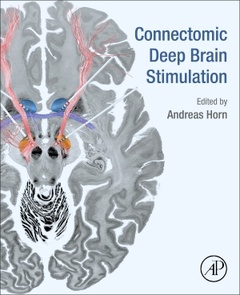Description
Connectomic Deep Brain Stimulation
Coordinator: Horn Andreas
Language: English
Subjects for Connectomic Deep Brain Stimulation:
600 p. · 19x23.4 cm · Paperback
Description
/li>Contents
/li>Biography
/li>Comment
/li>
Connectomic Deep Brain Stimulation (DBS) covers this highly efficacious treatment option for movement disorders such as Parkinson?s Disease, Essential Tremor and Dystonia. The book examines its impact on distributed brain networks that span across the human brain in parallel with modern-day neuroimaging concepts and the connectomics of the brain. It asks several questions, including which cortical areas should DBS electrodes be connected in order to generate the highest possible clinical improvement? Which connections should be avoided? Could these connectomic insights be used to better understand the mechanism of action of DBS? How can they be transferred to individual patients, and more.
This book is suitable for neuroscientists, neurologists and functional surgeons studying DBS. It provides practical advice on processing strategies and theoretical background, highlighting and reviewing the current state-of-the-art in connectomic surgery.
1. Deep Brain Stimulation – an Introduction
2. The “connectomic revolution in the field of neuroimaging
3. The mechanism of deep brain stimulation
Part II: DBS Imaging Methods
4. DBS Imaging - An Overview
5. DBS Imaging Methods I: Preprocessing
6. DBS Imaging Methods II: Electrode Localization
7. DBS Imaging Methods III: Estimating the electric field and Volume of Tissue Activated
8. DBS Imaging Methods IV: Stereotactic Spaces
9. DBS Imaging Methods IV: Group Analyses
Part III: Connectomics in DBS
10. Resting-State functional MRI based Connectivity
11. Diffusion-weighted MRI based Connectivity
12. Normative Connectomes and their use in DBS
13. Investigating Network Effects of DBS with fMRI
14. High-Resolution Resources and Histological Mesh Tractography
15. Using brain lesions to inform connectomic DBS
16. Electrophysiological connectivity measures from DBS-targets in Parkinson’s disease and Dystonia
Part IV: Applications of Connectomic DBS
17. Predicting treatment response on a local level
18. Predicting treatment response based on DBS connectivity
19. Connectomic DBS in Parkinson’s Disease, Essential Tremor and Dystonia
20. Connectomic DBS in Major Depression
21. Connectomic DBS in Obsessive Compulsive Disorder
22. Connectomics in the Operation Room
23. Investigating cognitive neuroscience concepts using connectomic DBS
24. Combining invasive and noninvasive neuromodulation techniques via connectomics
Part V: Outlook
25. Outlook: Toward Personalized Connectomic Deep Brain Stimulation
26. Whole-brain modelling to predict optimal DBS targeting
- Written to provide a "hands-on" approach for neuroscience graduate students, as well as medical personnel from the fields of neurology and neurosurgery
- Includes preprocessing strategies (such as co-registration, normalization, lead localization, VTA estimation and fiber-tracking approaches)
- Presents references (key articles, books and protocols) for additional detailed study
- Provides data analysis boxes in each chapter to help with data interpretation




